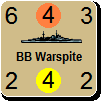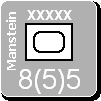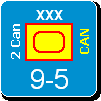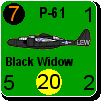warspite1
Posts: 41353
Joined: 2/2/2008
From: England
Status: offline

|
Please see attached ASW counter for the Germans.
[4811 ASW Escort - by Robert Jenkins]
.P These counters do not represent an individual convoy or any specific ships,
but are designed to represent convoy escort groups. They have mixed values
reflecting the fact that the make-up of an escort group could differ from one
convoy to the next. The date on the back of these ASW and ASW Carrier counters
should be ignored for the purposes of these write-ups.
.P The convoy escort role was important to the German Navy as much equipment,
troops and supplies were moved by sea; for example to Norway and Finland, and via
coastal routes, along the French coast, through the English Channel etc.
.P However, the type of escorts required and the make up of the escort groups
were clearly quite different from those required by the British and United States
in particular, and the need for specialist anti-submarine warfare escorts was
much less. Instead, the typical coastal escort would consist of torpedo boats,
minesweepers and other smaller craft to augment the few destroyers available to
the Kriegsmarine. Therefore the German ASW Escort counters may be considered
"what if" counters.
.B
.B Name: Wilhelm Heidkamp
.B Engine(s) output: 70,000 hp
.B Top Speed: 40 knots
.B Main armament: 5 x 5-inch (127mm), 4 x 37mm guns
.B Displacement (full load): 3,415 tons
.B Thickest armour: Not Applicable
.P The first destroyer type built for the Kriegsmarine after World War I was
the 1934 type, and all subsequent destroyer classes were variations on their basic
design.
.P The six destroyers of the 1936 type were built for the Kriegsmarine between
1936 and 1939. They were fast and powerfully armed vessels featuring a 5-inch
main armament and a sensible anti-aircraft (AA) battery of 37mm and 20mm guns.
They were better handling than the original 1934 type, as a result of a reduction
in top weight. They were also less fragile; both structurally and mechanically.
.P This ASW write-up looks at the invasion of Norway, and specifically the
destroyers of Marine Gruppe 1 that carried troops to the northern most invasion
target; Narvik. Speed was essential for this element of the operation and
therefore ex-civilian transport vessels could not be used; the transports were
the escorts.
.P On the 7th April 1940 almost the entire Kriegsmarine were deployed for
Operation Weserubung; the attack on Norway. For this audacious operation, the
Germans employed six main groups (Marine Gruppe) each with a specific destination
on the Norwegian coast.
.P Marine Gruppe 1 was made up of ten destroyers commanded by Kommodore Bonte in
his Flagship Wilhelm Heidkamp. The ships involved were: Wilhelm Heidkamp, Diether
Von Roeder, Erich Giese, Bernd Von Arnim, Georg Thiele, Wolfgang Zenker, Erich
Koellner, Hermann Kunne, Hans Ludemann and Anton Schmidt. They were tasked with
taking 2,000 mountain troops of the 139th Gebirgsjager Regiment to Narvik. Marine
Gruppe 1 were covered by the battlecruisers Scharnhorst and Gneisenau for much of
the journey. They left Germany late on the 6th April and survived an attack by
aircraft from the Royal Air Force after being spotted the following day. After
this, the ships were able to enjoy the cover provided by the poor weather and so
were able to reach Ofotfjord in the early morning of the 9th. Only in the final
stages of the journey north were they detected again, this time by the Norwegian
Navy.
.P Each destroyer had a job to do and each was able to accomplish its allotted
task under cover of poor visibility. While one destroyer, guarded the entrance
to the fjord, three ships were sent into Herjangsfjord, north of Narvik in order
to land the 1st Battalion at Bjerkvik. Two companies were landed to silence
Norwegian batteries guarding Narvik, however these were actually empty of guns
due to financial constraints between the wars. The remaining ships continued on
toward Narvik.
.P The Norwegian coastal defence ships Eidsvold and Norge had been alerted to the
German presence previously and Eidsvold, further down the fjord, prepared to
engage. Instead, the Germans sent an officer from Heidkamp to meet with his
opposite number on Eidsvold in an effort to get the Norwegians to surrender. At
the end of the protracted meeting, the Norwegians confirmed that they would fight
rather than surrender. The Germans had used the time well, ensuring that their
torpedoes were trained on the elderly Norwegian ship.
.P As soon as it was clear that a battle would be fought, the Eidsvold prepared
to fire at Heidkamp; she never got the chance. just after 0430hrs, three
torpedoes slammed into her, igniting her magazine, and the blast cut the ship in
two, causing her to sink immediately with heavy loss of life.
.P Those on board Norge heard the blast and prepared to fire as soon as they
could see a target out of the mist. The captain of the Norge was suddenly
confronted with the site of a German destroyer; the Von Arnim, ahead of him.
Eight minutes after the Eidsvold succumbed, Norge and Von Arnim briefly duelled
at point blank range before the German destroyer launched a spread of torpedoes
that caused the Norge too to sink very quickly.
.P The remaining two battalions of mountain troops and their headquarters staff
were unloaded and quickly secured Narvik. However, the victory came with problems
for Bonte and his destroyers. The plan called for them to be refuelled by two
tankers; one that had sailed from the Soviet Union and the other, from Germany.
The first was able to rendezvous in Ofotfjord and partly refuel the destroyer
force. However, the second vessel had been scuttled by its crew after being
intercepted by a Norwegian auxiliary. The repercussions of this encounter
for the Kriegsmarine were to be considerable.
.P Units of the Royal Navy had been at sea at the time of the German invasion as
the British were planning operations of their own in Norway. One such plan was for a
minelaying operation off the Norwegian coast in order to disrupt German Iron Ore
convoys coming from Narvik. For this, the 2nd Destroyer Flotilla provided the
escort for the minelaying destroyers. They were therefore in the area when news
of the German landing at Narvik came through. The initial report suggested that
one enemy ship was present in the fjord. The five British destroyers, Hotspur,
Hunter, Hostile, Havock and Hardy, commanded by Captain Warburton-Lee in Hardy,
were ordered to head for Narvik.
.P The Royal Navy ships were out-numbered and out-gunned but regardless,
Warburton-Lee sailed up Ofotfjord at first light on the morning of the 10th. The
British ships were able to surprise their German counterparts and quickly sank
Heidkamp and Schmidt. Bonte was killed aboard his Flagship. They also badly
damaged Von Roeder and lightly damaged two others. In addition, six cargo vessels
were destroyed.
.P Warburton-Lee then set about returning to sea but were pursued by the
remaining German ships, including the three that had been posted to Herjangsfjord
the previous day. In addition, two destroyers were in Ballangenfjord, and these
were able to surprise the British while bringing all guns to bear. Hardy was so
badly damaged in the encounter that she had to be beached. Warburton-Lee was one
of those killed. Hunter was also sunk. She was rendered disabled and motionless
in the water and was then struck by the badly damaged Hotspur. Hotspur was able
to get away along with the remaining two ships.
.P To compound the earlier German misery, Thiele was damaged in the latter stages
of the battle together with the supply ship Rauenfels, which was full of
ammunition and blew up when hit. The next day Koellner was damaged when she ran
aground in the fjord.
.P Bonte won the Knight`s Cross for his part in the action and Warburton-Lee won
the Victoria Cross; both posthumously.
.P Three days later the Royal Navy returned to finish the job. This time, the
Royal Navy had the superior numbers and the superior fire power as the battleship
Warspite had arrived to support a force of nine destroyers. The destroyer force
consisted of four Tribal-class: Bedouin, Cossack, Punjabi and Eskimo and five
others: Kimberley, Hero, Icarus, Forester and Foxhound. It was to be a one-sided
contest as the German ships were short of both fuel and now, ammunition too. The
Germans had the advantage of a submarine in the fjord, but she was quickly
destroyed by an aircraft from Warspite.
.P The first destroyer to be attacked was the Koellner, which had also been
spotted by Warspite`s aircraft and sank due to gunfire and torpedoes. The German
ships, now under the command of Kapitan Bey fought bravely considering their
hopeless position, but failed to make a significant impression on the British.
.P Eventually they had no choice but to retreat further back within the fjord.
Kunne`s captain chose to beach and then scuttle her when he had run out of
ammunition. Eskimo pursued Kunne and was attacked by two destroyers, losing her
bow in the process. The final destroyers to be sunk were Roeder and Giese. The
remaining ships were scuttled.
.P In the two battles the Germans had lost a large part of their destroyer force
and well over 1,000 sailors. This was in addition to the six freighters, an
ammunition ship and a submarine. The surviving sailors formed an adhoc fighting
unit that fought alongside the mountain troops of the 139th Regiment. Although
ultimately a British, French and Polish force managed to wrest control of Narvik,
it was a phyrric victory. The decision to evacuate Norway had already been made.
_____________________________
England expects that every man will do his duty. Horatio Nelson October 1805  |
 Printable Version
Printable Version

 will amend to ....named after the bloodiest single-day battle of the US Civil War.
will amend to ....named after the bloodiest single-day battle of the US Civil War. 










 - is why was Antietam acceptable as a name and none of the other civil war battles?
- is why was Antietam acceptable as a name and none of the other civil war battles? 
 New Messages
New Messages No New Messages
No New Messages Hot Topic w/ New Messages
Hot Topic w/ New Messages Hot Topic w/o New Messages
Hot Topic w/o New Messages Locked w/ New Messages
Locked w/ New Messages Locked w/o New Messages
Locked w/o New Messages Post New Thread
Post New Thread